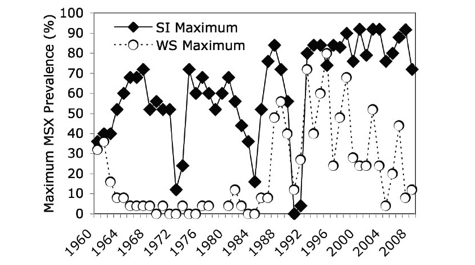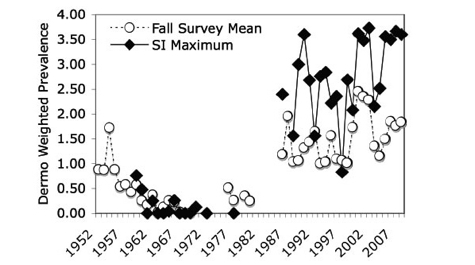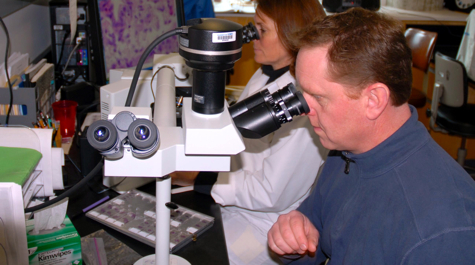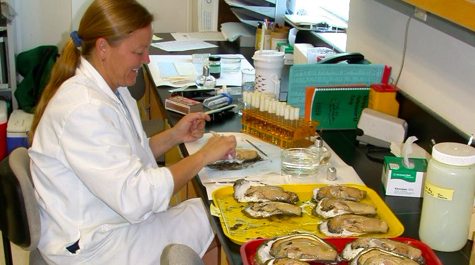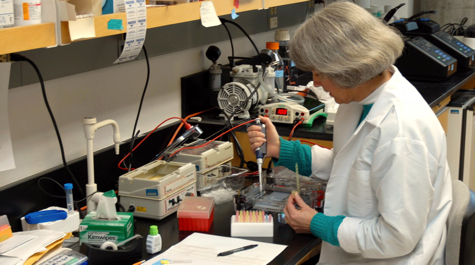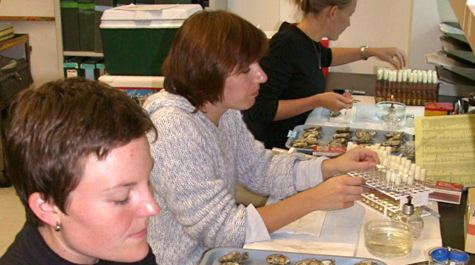Long-term study shows oysters developing disease resistance
This is despite the increasing prevalence in the Bay of the parasites that are responsible for the two diseases. MSX disease results from an infection by the single-celled protozoan Haplosporidium nelsoni. Dermo is caused by the parasite Perkinsus marinus.
Researchers in VIMS' Shellfish Pathology Laboratory began gathering the data in 1960 as part of their "Spring Imports" project. Each May, the researchers collect about 700 oysters from a disease-free area in the Bay. The current collection site is in the upper reaches of the Rappahannock River near Ross Rock, where low-salinity waters inhibit the parasites that cause MSX and Dermo disease.
The researchers then transport these disease-free oysters to the saltier waters of the York River near VIMS, where they are placed in cages and monitored each month through October for signs of disease.
Ryan Carnegie, an Associate Research Scientist in the Shellfish Pathology Lab, says "These oysters are completely naïve, having undergone no selection for resistance to disease. The prevalence of parasites in their tissues at the end of the summer thus tells us how much MSX and Dermo is really out there in the Bay."
Results of the monitoring program show an upward trend in the prevalence of both diseases among the transplanted oysters. Infection rates for MSX have risen from 35-40% in the early 1960s to 80-90% since 2000. Dermo was rarely encountered in the transplanted oysters until the mid-1980s, but now has a significant impact.
Professor Eugene Burreson, who heads the Shellfish Pathology Lab at VIMS, says "our monitoring program shows that disease pressure is really high and increasing." Burreson has led the program since 1982, following the retirement of VIMS professor Jay Andrews, an early pioneer in oyster-disease research. Andrews began the Spring Import project in 1960, the year after MSX first appeared in Chesapeake Bay.
Good News
The good news from the research group comes from their two other studies of wild oysters in the James River. Despite the increasing abundance of disease-causing parasites among the spring imports, data from these studies show a decrease or leveling off in MSX and Dermo among resident oyster populations in the lower James."The Wreck Shoal study in the lower James provides the most complete long-term study of disease prevalence on a wild oyster reef," says Burreson. "It clearly shows increased resistance to MSX in response to increased disease pressure." The prevalence of MSX among Wreck Shoal oysters has fallen from a high of 82% in 1996 to under 50% during recent years, and serious infections have become rare.
The Fall Survey of Dermo disease in Virginia oyster populations tells a similar story. Although the impact of Dermo among wild Chesapeake Bay oysters is still significant, it is much lower than that seen in the "naïve" spring imports in the York.
Carnegie says "decreased disease in the wild despite favorable conditions for the parasites is a clear sign of increasing resistance among our native oysters due to long-term exposure."
The data also show occasional sharp drops in infection rates during wet years, when freshwater runoff lowers the Bay's salinity. The parasites that cause MSX and Dermo prefer salinities above about 10 parts per thousand (ppt). Salinity in the brackish waters of Chesapeake Bay can range from 5-30 ppt depending on rainfall, tides, and other factors. The salinity of seawater is around 35 ppt.
Burreson says that no one knows how wild oysters have begun to resist succumbing to MSX and Dermo. "We simply don't understand the host defense mechanism," he says.
Understanding the genetic basis of resistance could help efforts to restore oysters to the Bay and to enhance oyster aquaculture. "Discovering a genetic marker that correlates with disease resistance would speed up the process of artificial selection," says Burreson. "Breeding oysters with those markers could make incremental gains in disease resistance much larger."
Researchers at VIMS, including Kim Reece, Stan Allen, Fu Lin Chu, and Steve Kaattari, are collaborating on the problem, as are colleagues at other institutions, including Ximing Guo of Rutgers University. Reece and Guo are mapping the oyster genome in search of the gene sequences that might impart resistance. Allen, Director of the Aquaculture Genetics and Breeding Technology Center at VIMS, is leading efforts to evaluate resistance of different oyster strains in field and laboratory trials. Chu and Kaattari have focused their research on the molecular basis of disease resistance.

